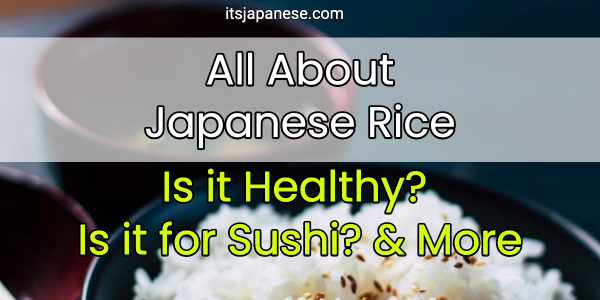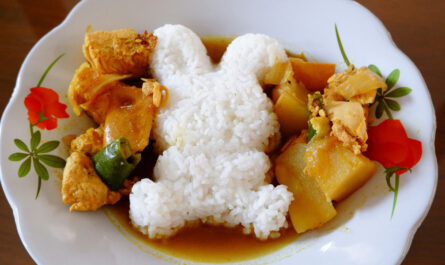In this guide, you’ll learn…
- An introduction to Japanese Rice
- Types of Japanese-style rice
- Is it Healthy? Nutritional Content & Benefits
- What is Sushi Rice?
- Rice Brands
So first, here’s a quick introduction…

1. An Introduction to Japanese Rice
In Japanese cuisine, almost every meal comes with rice. Rice is such a central part of the food culture that the word for “food” is called rice or ご飯 (gohan).
In fact, rice is the star of the show, or the “main dish.” You eat it with a variety of side dishes, meats, veggies, and soup.
Rice also guest-stars in plenty of other dishes: from sushi, sake, and even desserts like mochi (or sticky rice cakes).
The everyday rice that Japanese people eat — is a type of rice called Japonica rice. Japonica rice is known for its stickiness that is perfect for eating with chopsticks and holds together well. Compared to what you might consider “white rice” outside of Japan, it is less dry and with shorter grains. The Japanese almost exclusively eat this type of rice as it works well in the cuisine and still tastes good when it is cold.
Summary:
- Known as Japonica Rice.
- Sticky and clumps well together with other rice grains.
- Compared to regular white rice, it’s less dry and has shorter grains.
- 190 calories per ¼ cup of dry rice.
- Good source of plant-based protein and iron.
2. Types of Japanese-style rice
Now, are there different kinds of Japanese-style rice? Let’s take a look.
A. Japanese sushi/white rice
This is the most common type of rice that’s eaten in Japan. It is a short grain, Japonica variety rice that is sticky. In western grocery stores you’ll find the rice labeled as “sushi rice”. However, it is actually used as a part of everyday meals in Japan. This rice is known as hakumai meaning “white rice”, in Japanese.
This is also the best type of rice for Japanese curry.
B. Japanese brown rice
Whether a rice is brown or white is dependent on how much it is milled. If the Japonica rice is not milled as much and retains a brown color, it is considered Japanese brown rice. This is called genmai or haigamai in Japanese. In modern day Japan, brown rice is only eaten as a health food and most people prefer white rice.
C. Sweet rice/mochigome
This is a type of Japonica rice that has even shorter grains and it is even stickier. This rice is used for Japanese dishes which require an extremely sticky texture. The most popular food made from this rice is mochi, which are sticky rice cakes. Mochi is made by pounding the cooked mochigome, until it reaches a smooth and sticky consistency.
D. Calrose rice
In the 1940’s a new type of rice was developed in California which is close to the Japonica variety grown in Japan. California has a large Japanese immigrant community, and there was a need outside of Japan to get Japanese-style rice. Although American grown, this rice can also be used for sushi and all types of Japanese cuisines.
3. Is It Healthy? Nutritional Content & Benefits
Is it healthy? Well…
Japan boasts one of the highest life expectancies in the world. This can be linked to eating rice as the center of its cuisine. Although Japanese people eat lots of rice which are high in carbohydrates, there is very little fat in each meal. The rice is cooked with only water, avoiding ingredients which are high in fat.
In terms of nutritional content, Japanese white rice is relatively healthy.
There are about 190 calories per ¼ cup of dry rice.
It’s also a good source of iron and plant-based protein.
4. What is Sushi Rice?
Many people get confused by the labels on the bags of rice when it says “sushi rice”.
Japanese white rice is often sold by this label in the west. However, it’s important to keep in mind that this just means that the rice is suitable for sushi. Feel free to use rice labeled as sushi rice for any time you want to cook a Japanese meal.
That being said, you may have noticed that the rice in sushi tastes different from normal white rice. This is because sushi rice must be mixed with sweetened rice vinegar before it is used in sushi. The vinegared rice balances well with the raw fish.
5. Japanese Rice Brands
Now, if you’re looking to buy rice from outside of Japan and want to know some common brands, check these out.
For the most part, you can go use any of these rice brands for sushi, onigiri, curry, and more.
You can also check the rice brands on Amazon (affiliate links).
1. Nishiki
This is a medium grain white rice that is grown in California. It is one of the most widely available Japanese-style rice brands outside of Japan. It is perfect for making sushi and more affordable than Japanese-grown rice.
You can definitely use this rice for sushi, onigiri/rice balls, and Japanese curry.
2. Shirakiku Rice Koshihikari
If you’re looking for rice that has originated in Japan, this brand uses koshihikari rice. Koshihikari is a type of Japonica rice that has a very sticky texture and shine.
You can also use this rice for onigiri, sushi, and just eating as part of meals.
3. Nozomi Super Premium Short Grain Rice
This is also a koshihikari rice that is grown in California. It is grown with care and it is polished so that you don’t have to wash it prior to cooking.
4. Niigata Koshihikari
This is a brand of koshihikari rice that is grown in Niigata prefecture. The minerals in the water in the rice fields create a rice that is of the highest quality. If you want to try rice that is grown in Japan, this is highly recommended.
5. Kijima Tsuyahime Yamagata Rice
Yamagata prefecture is known for its rice growing. This rice brand uses Tsuyahime, translating to shining princess, which is a type of Japonica rice that has an unbelievable shine.
6. Akafuji Akitakomachi
Another variety of Japonica rice is called akitakomachi. This rice is named after the prefecture of Akita. It is less sticky than koshihikari and has a lighter texture. One of its defining characteristics of this brand is that it is still delicious after it has cooled down.
7. Shinmei Miyagi Hitomebore
This brand uses a rice called hitomebore, which means “love at first sight”. It is a variety grown in Japan, and the rice is shiny with a nice texture. It’s great for everyday meals and yes… this is the best rice for Japanese sushi.
Conclusion
Now you know quite a bit about rice from the land of the rising sun — what makes it special, what kind of brands to get, and much more.
– Team IJ (ItsJapanese)

[…] can also use this phrase to get extra Japanese rice if you’re still […]